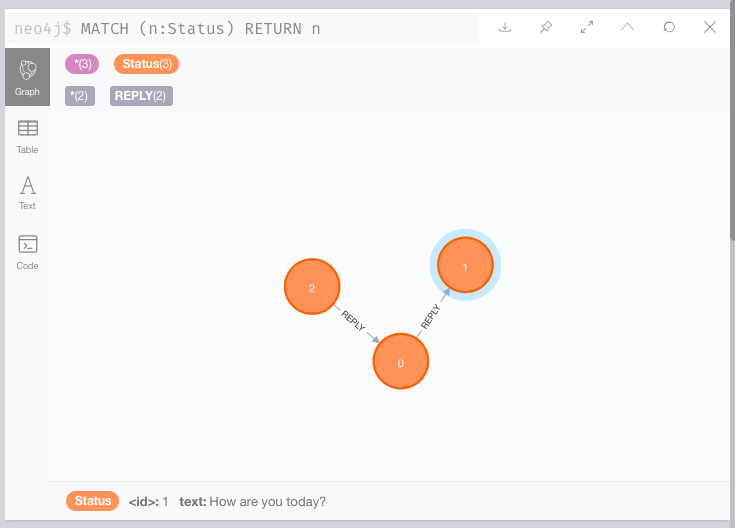Ecosyste.ms: Awesome
An open API service indexing awesome lists of open source software.
https://github.com/a03ki/chatdb
ChatDB is a toolkit to easily store chat messages in DB.
https://github.com/a03ki/chatdb
neo4j nlp
Last synced: 16 days ago
JSON representation
ChatDB is a toolkit to easily store chat messages in DB.
- Host: GitHub
- URL: https://github.com/a03ki/chatdb
- Owner: A03ki
- License: mit
- Archived: true
- Created: 2020-10-21T00:44:04.000Z (over 4 years ago)
- Default Branch: main
- Last Pushed: 2020-10-21T03:47:58.000Z (over 4 years ago)
- Last Synced: 2024-09-29T07:20:11.002Z (4 months ago)
- Topics: neo4j, nlp
- Language: Python
- Homepage:
- Size: 47.9 KB
- Stars: 6
- Watchers: 3
- Forks: 0
- Open Issues: 0
-
Metadata Files:
- Readme: README.md
- License: LICENSE
Awesome Lists containing this project
README
# ChatDB for NLP
ChatDB is a toolkit to easily store the conversation such as chat messages in a database. You can use ChatDB as a way of storing text in a stage of collecting data for NLP.
DBMS: [Neo4j](https://neo4j.com)
## Installation
You can choose either A or B.
### A. The case to use Neo4j Desktop
If you will work on a host OS and use Neo4j Desktop, it is recommended to install ChatDB from the PyPI:
```bash
pip install chatdb
```
Download Neo4j Desktop from the following: [https://neo4j.com/download/](https://neo4j.com/download/)
### B. The case to use Neo4j on a Docker container
You can use Git to clone the repository from GitHub:
```bash
git clone https://github.com/A03ki/chatdb.git
cd chatdb
```
#### If you will work on a host OS:
```bash
pip install -e .
docker-compose up -d db
```
#### If you will work on a docker container:
```bash
docker-compose up -d
docker-compose exec app /bin/sh -c "[ -e /bin/bash ] && /bin/bash || /bin/sh"
```
## Usage
First, store the text data in a database.
```python
from chatdb import Graph, Status
# Create Status
s1 = Status(text="How are you today?")
s2 = Status(text="I’m okay, thanks. And you?")
s3 = Status(text="I’m awesome.")
# Construct a relationship between Statuses
s1.reply_from(s2) # s2.reply_to(s1)
s2.reply_from(s3) # s3.reply_to(s2)
# Create the handler for Neo4j
# Work on a docker container
graph = Graph("bolt://db:7687", password="your_password")
# Work on a host OS
# graph = Graph("bolt://localhost:7687", password="your_password")
# Store data
graph.merge(s2)
```
Next, extract the text from a database.
```python
from chatdb import Graph, TextOutputer, Status
graph = Graph("bolt://db:7687", password="your_password")
# graph = Graph("bolt://localhost:7687", password="your_password")
outputer = TextOutputer(graph)
print(outputer.match([Status]).extract_text())
print(outputer.match([Status]*2).extract_text())
print(outputer.match([Status]*3).extract_text())
```
Output:
```
[['I’m okay, thanks. And you?'], ['How are you today?'], ['I’m awesome.']]
[['I’m okay, thanks. And you?', 'I’m awesome.'], ['How are you today?', 'I’m okay, thanks. And you?']]
[['How are you today?', 'I’m okay, thanks. And you?', 'I’m awesome.']]
```
You can also use the Neo4j Browser to check data.
Try to go to `http://localhost:7474` in your web browser and run the query which is `MATCH (n:Status) RETURN n`.

How to delete all data: `MATCH (n:Status) DETACH DELETE n`
For more information on how to use Neo4j Browser, see [https://neo4j.com/developer/neo4j-browser/](https://neo4j.com/developer/neo4j-browser/).
## Support for collecting Tweet data
```bash
pip install tweepy
```
This example will store the timeline of Twitter, Inc and the tweet which this account are replying to.
```python
import tweepy
from chatdb import Graph, SimpleTweetStatus
from chatdb.tools import TweetArchiver
auth = tweepy.OAuthHandler(consumer_key, consumer_secret)
auth.set_access_token(access_token, access_token_secret)
api = tweepy.API(auth, wait_on_rate_limit=True,
wait_on_rate_limit_notify=True)
graph = Graph("bolt://db:7687", password="your_password")
# graph = Graph("bolt://localhost:7687", password="your_password")
archiver = TweetArchiver(graph, SimpleTweetStatus)
statuses = api.user_timeline(screen_name="Twitter")
for status in statuses:
in_reply_to_status_id_str = status.in_reply_to_status_id_str
if in_reply_to_status_id_str:
in_reply_to_status = api.get_status(in_reply_to_status_id_str)
archiver.add_status(**in_reply_to_status._json)
archiver.add_status(**status._json)
```
For more information on how to use Tweepy, see [Tweepy Documentation](http://docs.tweepy.org/en/latest/).